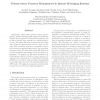41 search results - page 8 / 9 » Misuse Detection in Consent-Based Networks |
TNC
2004
13 years 7 months ago
2004
The function of a Network Intrusion Detection System (NIDS) is to identify any misuse and abnormal behavior determined as an attack to a network segment or network host. The propo...
COMPSEC
2002
13 years 5 months ago
2002
In this paper an insider attack is considered to be deliberate misuse by those who are authorized to use computers and networks. Applying this definition in real-life settings to ...
CCS
2006
ACM
13 years 9 months ago
2006
ACM
In this paper, we introduce the concept of witness anonymity for peer-to-peer systems. Witness anonymity combines the seemingly conflicting requirements of anonymity (for honest p...
ISI
2008
Springer
13 years 5 months ago
2008
Springer
An Intrusion Detection Program (IDP) analyzes what happens or has happened during an execution and tries to find indications that the computer has been misused. In this talk, we p...
IPPS
2006
IEEE
13 years 11 months ago
2006
IEEE
Information about online presence allows participants of instant messaging (IM) systems to determine whether their prospective communication partners will be able to answer their ...

